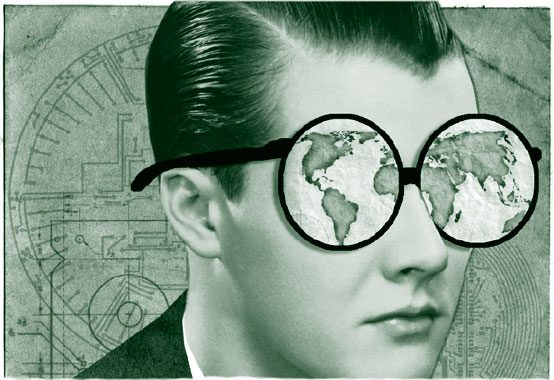lundi, 11 février 2013
The Map to Power
The Map to Power
The Revenge of Geography: What the Map Tells Us About Coming Conflicts and the Battle Against Fate, Robert D. Kaplan, Random House, 432 pages

Winston Churchill noted the symbiotic relationship between space and human action with the remark that “we shape our buildings, and afterwards our buildings shape us.”
On a much greater scale, consider how the physical world and its contours shape human development, just as humanity adapts the environment to its needs. The obvious faded from view in recent decades, however: globalization set the tone for the post-Cold War idea that old limits mattered little in a very new world. Grand, transformative projects sought to recast societies and institutions. Disappointment ensued with the failure of nation-building in the Middle East and the collapse of economic prosperity throughout the developed world.
In The Revenge of Geography, Robert Kaplan draws upon many thinkers, some unjustly neglected, to sketch a guide through the wreckage of these lost hopes. Far from creating the flat world Thomas Friedman described in his eponymous (and ephemeral) bestseller, globalization brings distant threats closer to home and draws differences into sharper relief. The future requires a new map.
Constructing the map to encompass geography in its fullest sense—embodying demographics, climate, and resources along with topography—highlights the factors that drive world trends. History and anthropology take the analysis further by providing context and showing how trends work over time. Geography, Kaplan argues persuasively, sets the framework within which contingency operates. International politics makes little sense without it.
Kaplan brings a reputation along with his point of view. His reporting from benighted regions during the 1990s drew criticism from liberal internationalists who objected to his pessimistic tone and caution about democracy-promotion. Deploying what John Ruskin called the innocent eye—an observer’s ability to see what lies before him rather than what he expects to see—Kaplan ignored the triumphalism of democratic capitalism to sketch a more complex and often bleak vista. Disdain for frivolous preoccupations among civilian elites drew Kaplan closer to the U.S. military, whose Spartan, practical ethos won his respect.
Experience—including with the Hobbesian nightmares of Afghanistan and Somalia, along with Saddam Hussein’s totalitarian experiment in Iraq—led Kaplan to back nation-building after 9/11. He joined the consensus behind the Iraq War and spent periods embedded with U.S. troops. While some commentators praised Kaplan as a latter-day Rudyard Kipling, others attacked him as a cheerleader for American empire. Kaplan himself admitted to having come too close to his subject and fallen prey to excessive zeal, even though he never took up the polarizing rhetoric of the Bush era. The Revenge of Geography marks a search for new perspective.
The way in which geographers, historians, and strategists traced their maps frames Kaplan’s discussion of geopolitics. He takes their ideas—particularly where diverging opinions raise conflicts—to pose questions rather than providing answers. Herodotus, whose account of the wars between the Greeks and Persia balanced geographic determinism with the decisions of men, represents the sensibility Kaplan seeks to recover. Environment sets a context, not least by shaping culture and custom, for decisions often made in the grip of passion. Dynamics shaping politics in the fifth century B.C. still operate today. Indeed, the region Herodotus describes between the eastern Mediterranean and the Iranian-Afghan plateau remains a critical area of conflict.
William McNeill, author of the 1963 landmark The Rise of the West, also looked to that area linking three continents for insight into the interaction between civilizations. Isolation along a fertile river surrounded by desert shaped Egypt by keeping outsiders at bay, while Mesopotamia remained vulnerable to predation. Both developed authoritarian, bureaucratic regimes, but Iraq had a more brutal political culture forged by insecurity. McNeil describes Greece, India, and China—all three developed unique civilizations, but distance kept China on a separate path while the ebb and flow of frontiers between Hellenistic, Middle Eastern, and Indian civilizations made for a delicate cultural balance in Greece, India, and the lands between. McNeill’s focus on interaction challenged the view of civilizations as developing separately, familiar from Oswald Spengler’s Decline of the West and Arnold Toynbee’s more optimistic account. McNeill’s idea of history as a study in fluidity gives Kaplan a starting point to consider geography’s impact upon social and political development in Eurasia.
The fact that Nazi Germany turned geopolitics to the service of conquest tainted the reputation of the field’s founding father, Halford Mackinder, but the continuing relevance of his ideas is undeniable. Geography, Mackinder argued, operates as the pivot of history by setting the context in which men and societies act. It forms barriers of desert, mountain, and tundra along with pathways of river valley and steppe. The seas acted as both, alternately providing a sheltering impasse and a highway transit.
Far from being an environmental determinist, however, Mackinder thought that understanding geographical limits pointed to ways of overcoming them. Indeed, Kaplan argues that his vision of geography’s role had a dynamic quality exactly opposed to the static assumptions of determinism. Technology, a form of human initiative, modified environments. Railways had a decisive impact by opening land to inexpensive transport of bulk goods. What began as a feeder to ocean or river transport eventually became a means of connecting Eurasia. Controlling its heartland would confer a decisive strategic advantage. Mackinder sought to chart trends rather than strategize conquest, but his analysis had an obvious appeal to the evil empires of Hitler’s Germany and Soviet Russia.
Where Mackinder and Nazi theorists like Karl Haushofer focused on the Eurasian heartland, the Dutch-born American Nicholas Spykman argued that projecting maritime power from the rimland built on advantages geography provided the United States. The combination of temperate climate and rich resources with effective hegemony over the Western Hemisphere gave the U.S. power to spare for adjusting the balance of power in the Eastern Hemisphere. The United States’ location provides access to Europe that South America lacks, while the Amazon and Arctic create secure buffers. Kaplan cites Spykman’s analysis as a way to see past the immediate press of events and discern basic geostrategic truths. His approach matters more than his conclusions themselves.
Earlier, Alfred Thayer Mahan offered in 1890 an historical account of sea power that still resonates among Chinese and Indian strategists. It influenced Spykman, along with Theodore Roosevelt and Germany’s Wilhelm II. Britain’s ability to control the seas by defeating enemy fleets during the 18th-century wars Mahan narrates ensured that maritime commerce would operate on British terms and rendered France vulnerable to coastal attack. Mahan’s contemporary Julian Corbett refined the analysis by arguing that a weaker fleet could effectively contest a numerically stronger foe by attacking bases and controlling vital choke points. Such leverage suited powers, like early 20th-century Britain, forced to meet widespread commitments with limited means. Maritime coalition building—and a presence in littoral spaces to affect land operations—offers an alternative to matching high seas fleets.
What do these ideas mean for understanding present discontents? Kaplan applies insights from these thinkers to sketch possibilities in key regions. Spykman warned that a united Europe would be a staunch competitor to the United States and perhaps the dominant outside power in equidistant parts of South America. Geography, however, has divided Europe to facilitate a balance of power since Roman times, as Edward Gibbon pointed out. Kaplan notes the appeal Mitteleuropa holds as a tolerant cultural zone dating from the Habsburg Empire, which joined pluralism with the impartial rule of law. The geographic space Central Europe occupies, however, serves as a crush zone between maritime and continental Europe. Peace might allow it to flourish, especially with Germany’s turn from war and Russia’s relative weakness.
Indeed, the search for peace has driven Europe’s efforts to rearrange itself since the 1950s. European integration, particularly in its post-Cold War phase, aims to transcend limits of history and geography to end conflict. Defying those limits, however, made the single currency a transmission mechanism for fiscal strain rather than a unifying force. Greece, as the weakest link in the project, offers a guide to the health of European integration. Its weakness derives from a history torn between Europe and the Middle East that left it politically and economically underdeveloped.
Gravity in the Middle East seems likely to shift toward Turkey and Iran, with Ankara providing a check on its rival. History and geography give logical frontiers to both, along with avenues of influence throughout the region. Other states lack such clear borders, making civil disorder in Syria a danger to Iraq and Jordan.
Geography also sets the terms for the problem China’s rise presents. A continental power like Russia, China also holds a large oceanic frontage onto the Pacific with good harbors. The combination provides strategic reach enhanced by decades of economic growth. Kaplan deftly notes the interaction between human initiative and geography over China’s history and how those factors shape its current ambitions.
But geographic factors also mitigate its advantages. Vietnam and Japan look to the United States for help in balancing China, while Korea’s unstable division presents a problem on its doorstep. The weakness of neighboring powers can trouble China no less than their strength. Sea power allows the United States to balance China without forcing a confrontation. Kaplan suggests that a struggle between them will be more stable than the Cold War rivalry with Russia was. Geopolitics shapes a subtle dynamic to influence other states while avoiding war.
Sketching geostrategic possibilities is a more useful exercise than making predictions. Kaplan articulates a realism focused on consequences that marks a welcome change from the fads and theories of the past 20-odd years. Instead of narrowing vision through a theoretical lens that hides facts out of line with theory, he draws upon those facts to press questions, and he thereby offers a more nuanced view. Seeing the world as it is, rather than as we might wish it to be, helps navigate the rapids of the turbulent era in which we live.
William Anthony Hay is a historian at Mississippi State University.
00:05 Publié dans Actualité, Géopolitique, Livre | Lien permanent | Commentaires (0) | Tags : livre, états-unis, robert kaplan, géopolitique, politique internationale, géographie, théorie politique, politologie, sciences politiques |  |
|  del.icio.us |
del.icio.us |  |
|  Digg |
Digg | ![]() Facebook
Facebook




Les commentaires sont fermés.